What is sales enablement? The 2024 ultimate guide to training your sales team

Sales Enablement Program Manager

Tags
Share
Sales enablement is the cornerstone of building a world-class sales engine (with world-class win rates). But it goes beyond simply hiring the right talent and offering basic training.
To truly empower your sales team, you need a well-rounded sales enablement strategy that includes equipping reps with the tools, skills, and knowledge they need to succeed.
This comprehensive guide will walk you through not just the importance of sales enablement but also how to build an effective strategy tailored to your business goals.
The most successful sales teams thrive on a combination of natural talent, a solid sales strategy, and the strength of the enablement programs supporting them. So, what does it take to set your team up for success? What tools and resources are essential? As a Sales Enablement Manager, these questions drive my focus every day.
So… What is sales enablement?
Sales enablement is essentially a way of developing your sellers' sales skills and techniques—often, while combining them with product-specific knowledge. The goal? To empower your SDRs, BDRs, AEs, Sales Engineers, and so on to effectively create and close sales opportunities for your business.
Sales enablement is generally not just a one-off session or a singular action. Often, sales training starts during the onboarding process and continues throughout the lifetime that a sales rep is with you. You may train your sales team yourself—or you may decide to hire an external agency to do an enablement or sales training course with your sales org.
Who owns sales enablement?
Sales enablement is a collaborative effort involving multiple departments. While often led by sales enablement managers, it requires alignment between key stakeholders:
Sales Leadership: Defines goals and ensures the enablement strategy aligns with sales objectives and performance targets.
Marketing: Provides content, messaging, and collateral to support sales reps in delivering consistent, compelling messages.
Product Team: Offers in-depth product knowledge and training, helping sales reps effectively position solutions.
Customer Success: Shares insights on customer feedback and usage, ensuring the sales team addresses customer needs effectively.
Ownership is shared, but sales enablement managers typically oversee coordination and implementation across these groups.
Why is sales enablement important?
Sales roles are one of the most unique, because you'll often get a huge mix of backgrounds and experiences when you're hiring new reps.
It's not uncommon to see sales reps with decades of experience, a few years of experience, or no selling experience at all—and sometimes folks who have no experience end up doing very well because of their tenacity and adaptiveness.
This is also why sales enablement is so important. When you have such a wide range of experiences and skills in team members, you need to get everyone on the same page, at the same level, as quickly and efficiently as possible. And that's not even considering industries or companies that sell very complicated products or software—in these situations, having good sales enablement is even more crucial.
Benefits of sales enablement
Sales enablement empowers teams with the resources, training, and tools they need to improve performance and increase revenue. It helps sales reps engage prospects more effectively, reduces onboarding time for new hires, and ensures alignment between sales and marketing efforts. By providing continuous learning and development opportunities, sales enablement ultimately drives higher win rates and customer satisfaction.
When is the right time to implement a sales enablement strategy?
The ideal time to implement a sales enablement strategy is when your sales team begins to scale, and you notice inconsistencies in performance or messaging. If your business is expanding into new markets, launching new products, or facing high turnover, a sales enablement strategy can provide the structure and resources necessary to maintain consistency, improve productivity, and support growth.
What are the defining principles of sales enablement?
Sales enablement is built on several key principles:
Alignment: Ensuring sales, marketing, and product teams work together seamlessly to support sales goals.
Training and development: Providing ongoing learning opportunities to help sales reps continuously improve their skills.
Content accessibility: Making sure relevant content and resources are easily accessible to reps when they need them.
Technology integration: Using tools and software to streamline processes, automate tasks, and provide actionable insights.
How to build a sales enablement strategy
Creating an effective sales enablement strategy involves several key steps:
Reporting and analysis
Track sales performance, identify gaps, and measure the effectiveness of enablement programs. Data-driven insights help refine strategies and demonstrate ROI.
Sales content optimization
Develop and organize sales materials that align with buyer personas and stages of the sales funnel. Regularly update content based on feedback and performance metrics.
Technology and automation
Leverage CRM systems, sales enablement platforms, and other tools to automate tasks, streamline processes, and provide real-time insights to sales teams.
Sales enablement software
Choose software that integrates with existing systems and supports training, content management, and analytics. The right technology enhances productivity and helps scale sales efforts efficiently.
6 sales enablement strategies for more effective sales training
1. Have easily accessible online learning materials
This one is especially important if you have remote sales reps or a distributed team. Being able to work from anywhere is one thing—but can your sellers learn from anywhere?
For example, do you have online sales training materials or an on-demand e-learning program to help your sellers learn about your products or services quickly and be able to handle objections? You could also have weekly webinars that talk about product updates that your sales reps should be aware of.
Sometimes, the best sales training programs are free. One feature we love using in Dialpad is the playlist feature—you can create a “playlist” of better sales calls that would be helpful for new reps to learn from, send them the playlist, and let them learn on their own time:
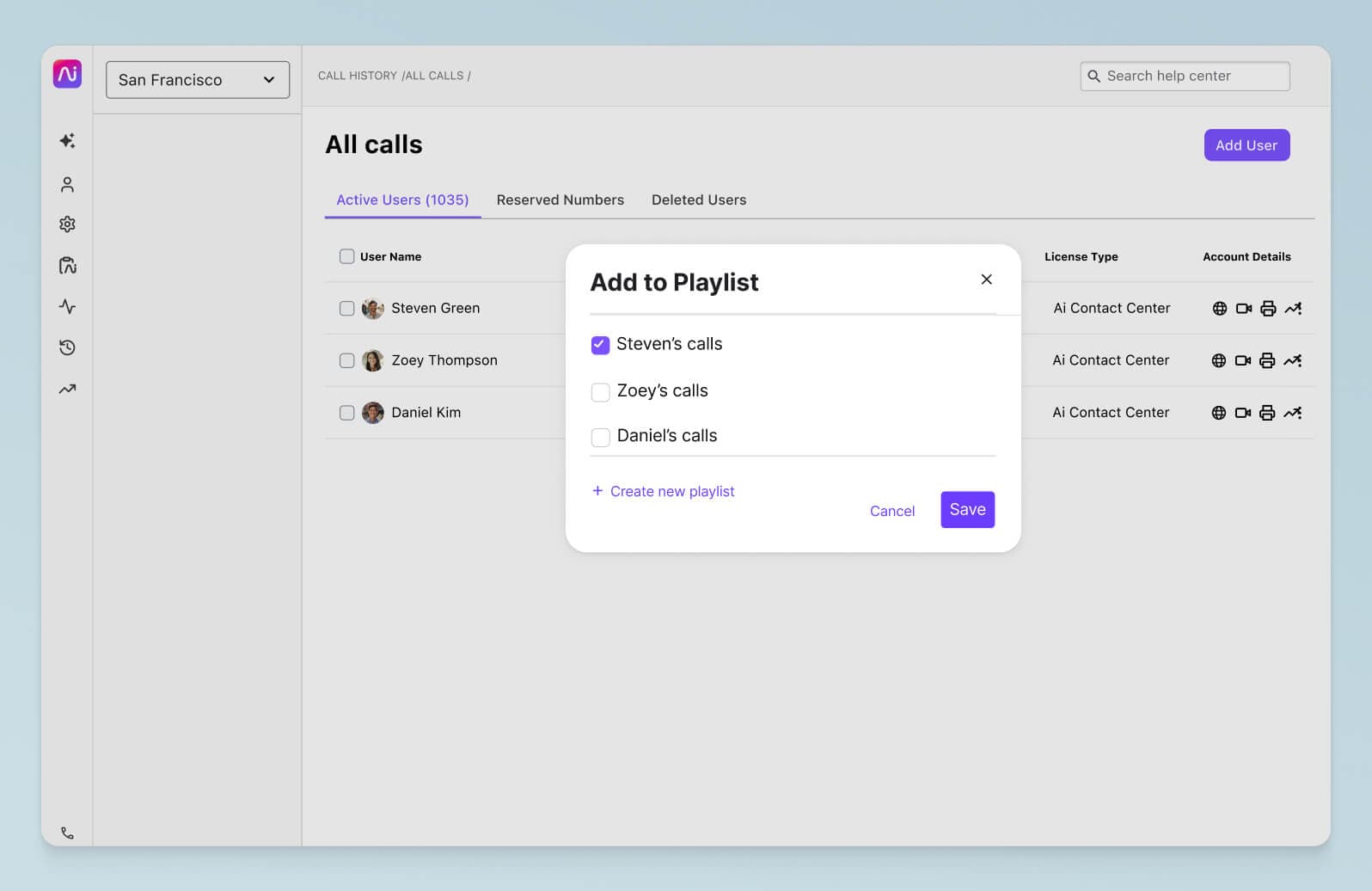
Depending on your resources, of course, you may be in a position to hire a training company to help too—these companies typically have specialized programs for sales professionals and may be able to support remote teams too.
2. Share sales success stories
On a related note, share success stories! These are often the best teachers when it comes to sales training, and case studies can not only give new sales reps real-life examples of how to close deals, but also reinforce training for more experienced sellers.
It’s not just a case of sharing the actual sale itself—but how the person achieved it, what sales technique they used, how they overcame objections, etc.
Again, make use of your call recordings as part of training—in Dialpad, all of our salespeople can see their recordings in the desktop and mobile app, in the same place where they can check their voicemails, start phone and video calls, and a lot more. They don’t need to toggle between different apps or windows, and it’s been huge for accelerating their activity and helping them be more productive:
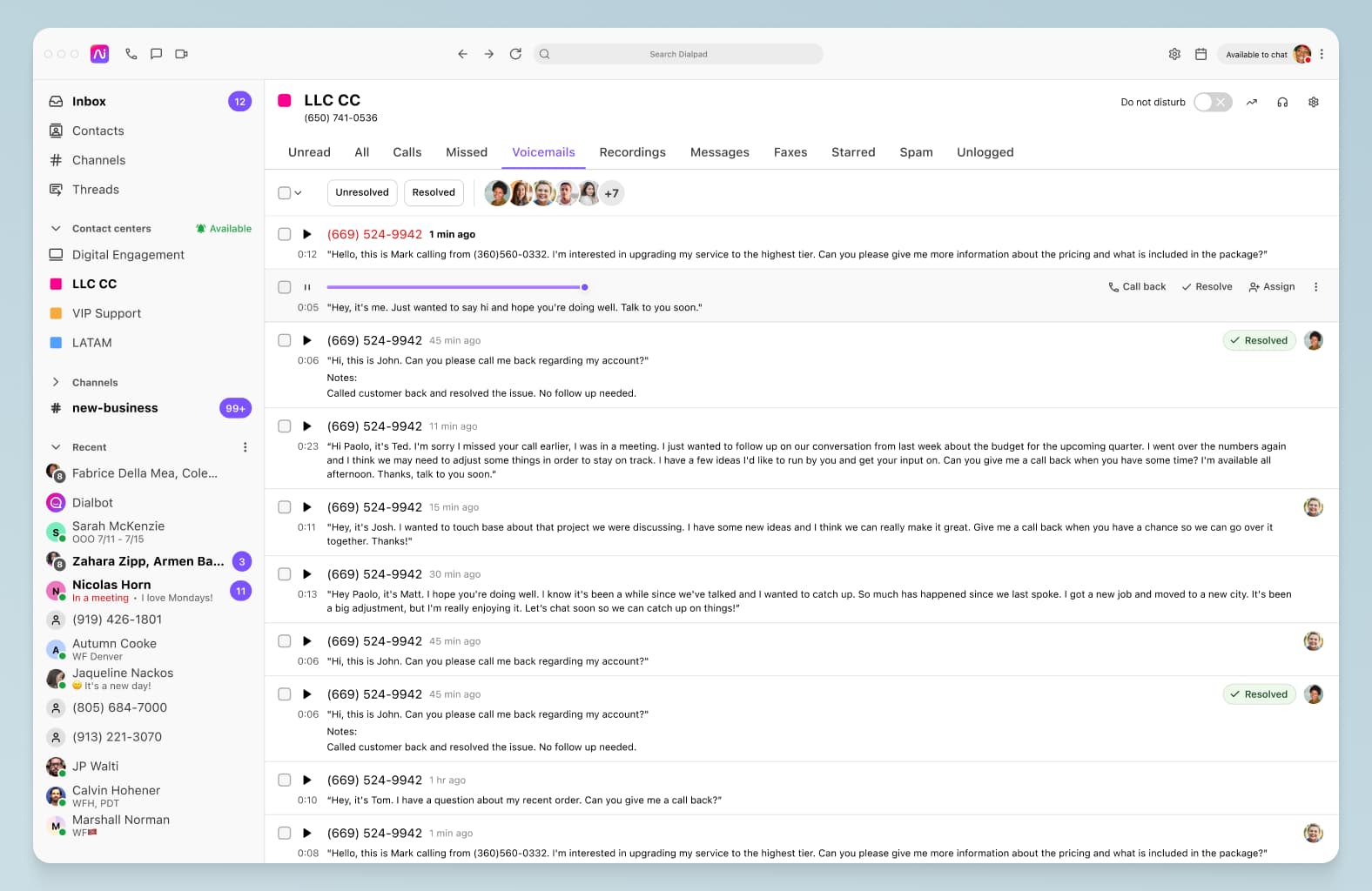
3. Provide constant and constructive feedback
This is a really important one—and both parts of this are important. Focusing purely on criticism doesn’t always help and can dent a seller’s confidence. And if you don’t provide feedback on a regular basis, you risk missing out on opportunities to keep your sales team updated on changes in the industry.
And of course, most feedback originates from your customers and prospects—but how do you track this feedback?
In Dialpad, we can create Custom Moments, which help us track how frequently certain topics are brought up on sales calls. (Learn more about sales call reporting and planning.) For example, if you’re interested in how often a competitor’s name comes up, you can create a Custom Moment for that!
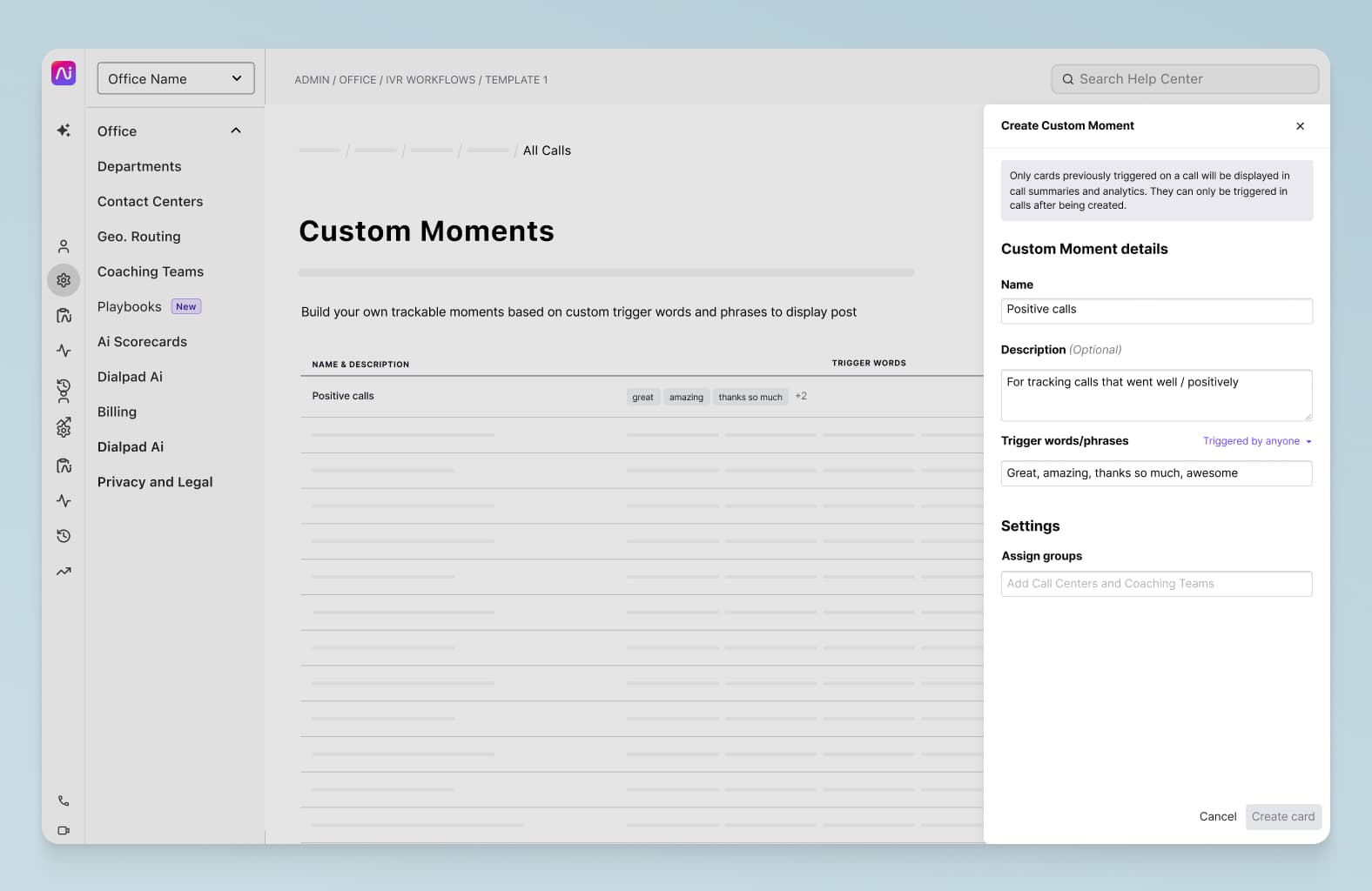
We can then see, in Dialpad’s analytics, how these moments are trending over time and keep an eye on what we need to train sellers to talk about.
One issue that sales managers often come across is that they just don’t have the time or bandwidth to review sales calls for coaching and feedback opportunities. Dialpad's Ai Scorecards can help with this, by reviewing calls for whether sellers did everything listed in the scorecard criteria.
It's pretty simple—sales managers and admins can easily create a QA Scorecard from their online dashboard, and as sales reps are having conversations with prospects, Dialpad Ai listens to each interaction and automatically suggests when the scorecard behavior is met:

Say you've added “Rep asked the prospect who the decision-makers are" to scorecard criteria. If the agent asks about decision-makers, whoever grades that call will immediately see that the activity was completed, without having to listen to the entire call recording or read the transcript. This helps us provide a lot more specific and constructive feedback, because we can point to the exact parts of the conversation where a seller did something right (which we can congratulate), and where they have an opportunity to improve.
4. Scale your sales training where you can
Here’s the thing. In most cases, you’re one person overseeing a team of sales reps—all of whom will need your help at some point. But you can’t be sitting on every single sales call and teaching everyone new skills.
So, look for ways to automate your sales training where you can. Some of the things I mentioned earlier, like using call recordings as a training tool, can already lighten the load, but there are cloud contact center platforms and other software that will help with this too.
For instance, with Dialpad, we can create Real-time Assist (RTA) cards, which are like cheat sheets that automatically pop up on our reps’ screens when certain words are spoken on sales calls.
For example, we can create an RTA card about how to port a number (which we can set to trigger when a customer says “port,” “porting,” and any other related words)—but you can easily create an RTA card for pricing, and set that to pop up whenever a prospects says “cost” or “price”:
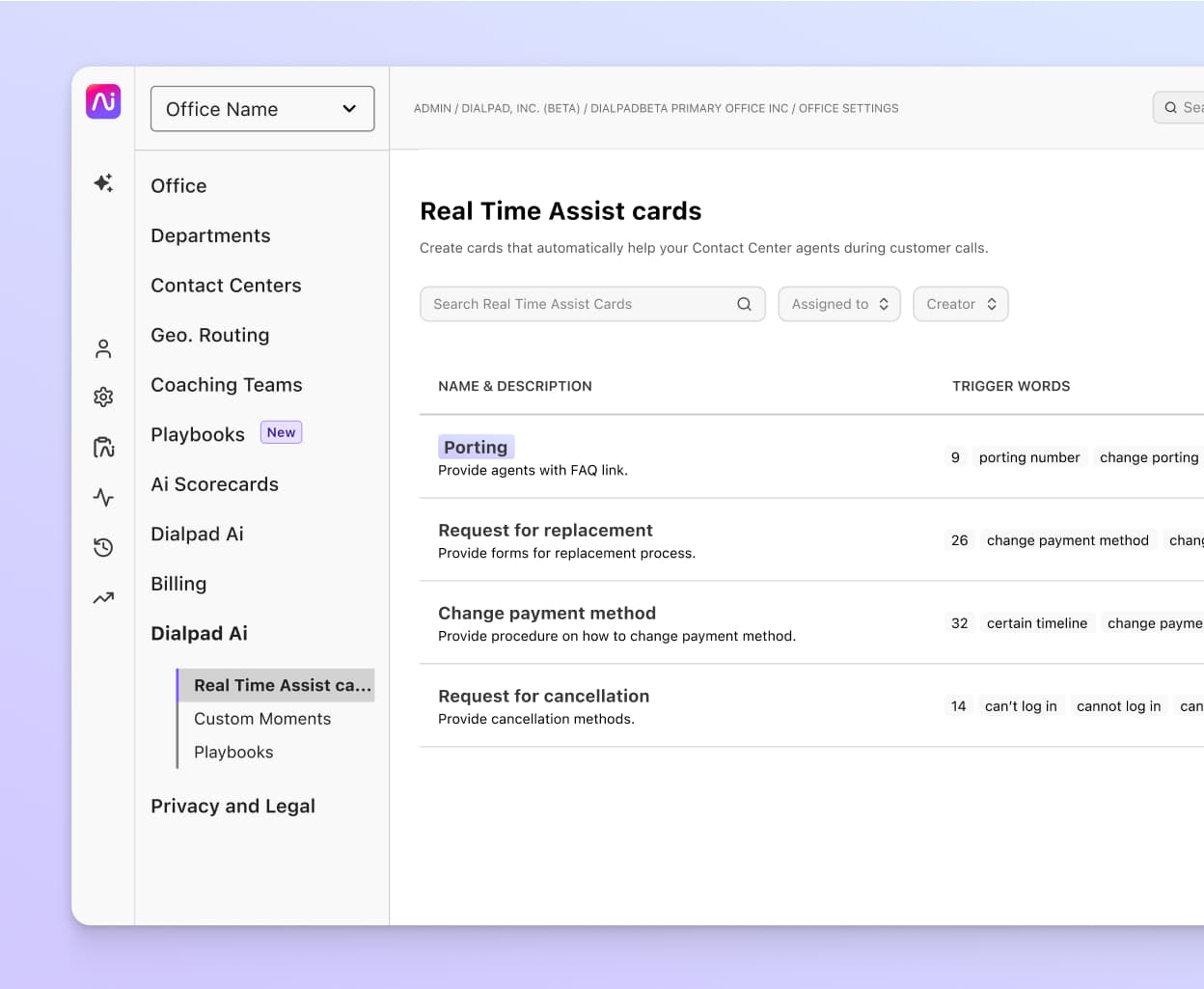
Not only that, Dialpad also has a unique Ai Playbooks feature, which helps coaches and supervisors track rep adherence to sales methodologies like BANT, SPIN, and SPICED more easily. Dialpad Ai can automatically suggest questions and phrases that they need to say during a call (for example, asking about budget or purchase timelines), understand whether the behavior was met, and check the task off the list (or notify managers if this isn't being done).
This is helpful for sales leaders, because they don't have to painstakingly review every single call, and can quickly tell which reps need additional coaching or if any parts of the sales playbook can be improved upon—all thanks to AI.
5. Schedule shadowing sessions for new reps
Shadowing is when a trainee watches (and listens) or accompanies a more experienced member of your team on the job.
For field sales, that would involve the trainee actually going on the road with a sales leader to see how the experienced salesperson operates and how they communicate with customers.
For any type of inside sales, technology would come to the rescue once again. The trainee doesn’t have to be in the exact same physical space as the person they’re shadowing—you can use call recording and monitoring to listen into calls.
For example, with Dialpad, it goes both ways—you can have new hires shadow more experienced salespeople on sales calls, and also have sales managers listen in on calls that these new reps are having.
6. Assign a designated mentor for each trainee
If you can, it’s worth assigning a mentor to each new staff member whenever possible. This gives your new staff someone to reach out to and ask those really specific on-the-job questions.
It also helps build bonds between existing team members and new hires.
Mentors don’t have to come from your training team, but would ideally be experienced team members and sales leaders who can share their know-how.
6 areas your sales training program should cover
1. CRM training
The advantages that technology can offer your sales teams can’t be understated. One of the best tools that sales teams can use is a CRM (customer relationship management) solution. This is your treasure trove of customer information that tells you about their previous behavior, identifies potential sales prospects, and gives you the best chance of making a connection.
If you use Salesforce, Dialpad’s integration with it can embed a power dialer right in your Salesforce dashboard and automatically log activities to streamline your team’s workflow:
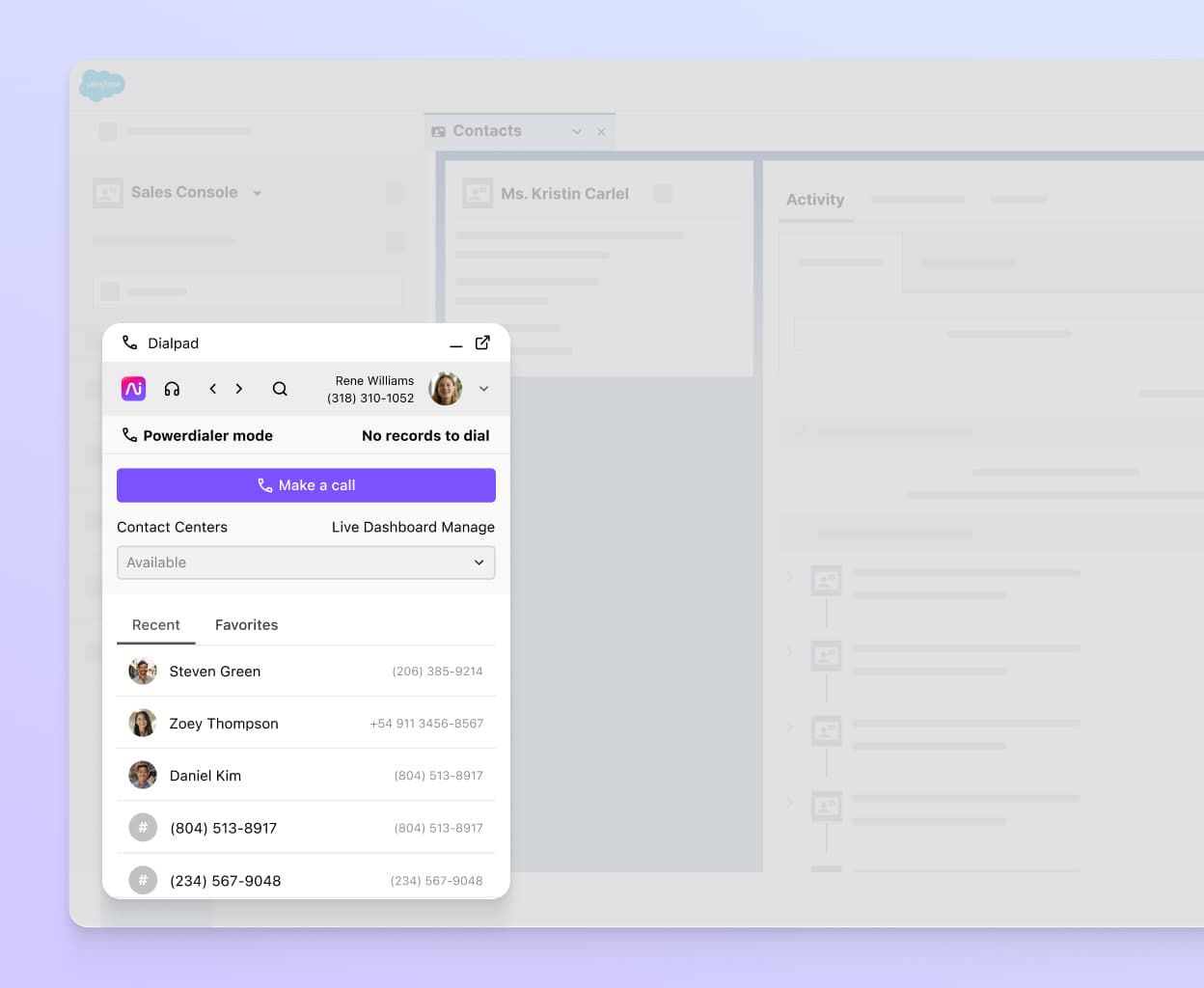
Dialpad also integrates with other CRMs like HubSpot and again, it embeds a CTI dialer inside those tools and the integration automatically logs every call as well as voicemails, messaging, and full transcripts:
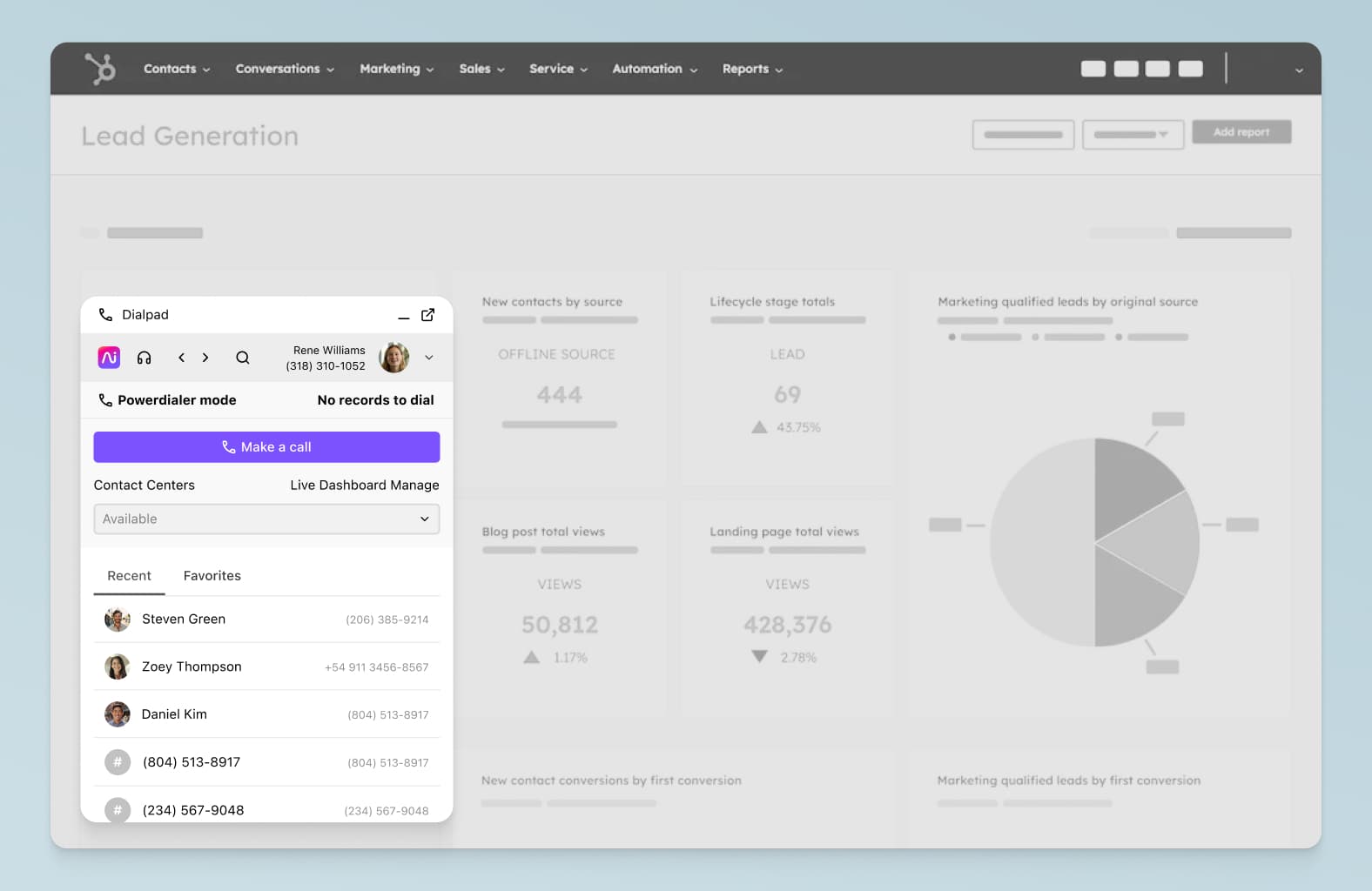
Whatever roles your sales teams are in, the technology they use (and don’t forget about social media platforms like LinkedIn) will likely be a major part of how they work. The tools you may use can differ according to industry and roles. Dialpad not only provides a unified communications platform but also integrations with a wide range of apps including Google Workspace (collaboration), Outreach (sales engagement), and many more.
2. Fundamental sales skills and actionable knowledge
Not everyone comes to sales with a background in sales. (In fact, some of the best salespeople often have very diverse backgrounds in other industries.) Knowing how to equip your trainees with the most vital selling skills is the foundation for their work with your business. That knowledge should include:
Your sales process, from prospecting and generating leads to follow-ups
Negotiation
Active listening
Product and organizational knowledge, and relevant pricing strategies
Presentation (role plays are great for this)
Basic tech skills (even if you’re not in tech, you probably use tech to communicate with prospects)
3. A well researched market
Your sales teams need a wide knowledge base to do their jobs effectively. And maybe the two most crucial bits of that knowledge are A) your products or services and B) the market you’re in.
Knowing all the features of the products they are selling and their benefits is important, yes, but knowing the market and your competitors is also crucial. Prospects can shop around online at their own leisure more easily than ever before, and if you have competitors, they’ll likely know about them.
For example, integrating CPQ software, or configure, price, quote software, into your sales process can streamline the configuration, pricing, and quoting, providing your team with a powerful tool to enhance their efficiency and deliver a seamless customer experience.
Your sellers have to be ready to speak to these—convincingly.
👉Dialpad tip:
Want to help your sales reps understand the market and competitive landscape better (and more quickly)? Create a playlist of calls where your competitors have come up in sales conversations.
4. Empathy and understanding for the customers
Some of your training has to focus outwards rather than inwards. After all, it’s no use having a rep with amazing business and product knowledge, but no empathy with your prospects.
Understanding your customers, their behaviors, their wants and desires, and what makes them decide to buy not only affects your sales figures, it helps provide a more positive buying experience. (And a good customer experience means you will more likely see good customer retention figures.)
5. Ongoing evaluation and improvements
Evaluating your sales training program is as important as evaluating the sales readiness of your trainees. Besides, the effectiveness of your training will have a direct influence on how good those trainees will turn out. You should evaluate your training program with four goals in mind:
Improvements. The whole point of evaluating your program regularly is to identify any areas needing improvement. Every year, your team should be a bit more knowledgeable—and hitting higher numbers. Is your program helping them do that?
Retention. Good training, and ongoing development, makes employees feel more valued (and more confident in their duties). If you invest in ongoing training and development, employees are likely to be happier and to stay with your organization.
ROI. You always have one eye on your bottom line—and making sure that your sales training provides a good ROI should be a part of that consideration. After all, well-trained reps are key to increasing your profits and future growth.
6. Customer support and success teams
Not all sales roles are sales roles! Many roles that are primarily inbound customer service-oriented will have sales aspects within them. For example, upselling and cross-selling during a customer service call can be major contributors to a company’s revenue stream.
This means if you’re training new agents, you might want to teach sales competency across these different roles. Customer Success teams don’t always sit under the sales org, but if you can exert some influence here and provide sales training opportunities for these folks, here are a few things to focus on:
Instill the habit of encouraging brand loyalty in customer conversations
Teach them how to resolve issues and ensure customer satisfaction while being able to identify potential sales opportunities
Find a way to measure sales performance for these non-traditional sales teams
Build an understanding of consultative selling
Help them recognize that aligning customer support or customer success with sales will drive your business’ organic growth
Sales enablement KPIs to track to measure your team’s progress
This is something that I see in a lot of articles, but there’s a bit of nuance that people don’t often talk about when it comes to sales enablement KPIs. A good enablement org doesn’t have static KPIs—it will focus its KPIs on the programs and initiatives the business is trying to drive.
That means that your sales enablement KPIs should be dynamic! Our team uses the Kirkpatrick model to evaluate the result of our sales training program. There are four key levels, or considerations, in this model:
Level 1: The reaction
Did your sellers like the training? How did they respond?
Level 2: Understanding
Did they “get” it? Could they pass a test if you asked them about what they learned?
Level 3: Change
Was there a behavior change? With any sales training or enablement program, your ultimate goal is to drive a change in behavior. Are your reps applying these learnings to their job?
Level 4: Results
Finally, did that program result in an organizational change or improvement in a metric that you’re tracking?
For example, let’s say one of our goals is to demystify AI for our sales reps. An enablement session we might have is to do a “pain” clinic, where we make sellers experience the pain of not having our amazing sales AI tools, and then re-enable it. We’ll then ask them, “What happened? What was that like?” Then we take those answers, which they come up with all on their own, and say, “That’s your pitch.”
If we use the Kirkpatrick model here, we’d consider the reaction that we get from reps (did they like that approach), whether the new pitches work, and so on. Dialpad’s call recordings help us easily tell if this results in a positive impact on their sales calls.
In terms of measuring results, we might measure the percentage of deals that include our AI products’ SKUs. Here, the KPIs for sales enablement are contingent upon the goals and outcomes of our enablement team (make sure our reps are confident in talking about Dialpad Ai), which are contingent on the goals of the business (sell more Dialpad Ai licenses).
Challenges to sales enablement
Sales enablement can face several hurdles, including misalignment between sales and marketing teams, lack of proper training programs, and inconsistent messaging. Other challenges include difficulty in measuring the effectiveness of enablement initiatives and resistance to adopting new technologies or processes. Overcoming these obstacles requires a clear strategy, cross-department collaboration, and a commitment to ongoing training and development.
Sales enablement best practices: How to succeed
To succeed in sales enablement, focus on these best practices:
Align teams: Ensure sales, marketing, and product teams are on the same page with shared goals and consistent messaging.
Prioritize training: Offer ongoing, personalized training that adapts to the needs of your sales reps at different stages of their careers.
Utilize technology: Invest in the right tools that streamline processes and provide actionable insights for continuous improvement.
Measure and optimize: Regularly track KPIs and use data to adjust strategies, ensuring your enablement efforts deliver results and ROI.
What tools are needed for sales enablement?
Effective sales enablement requires a suite of tools, including:
CRM systems: Centralize customer information and track interactions to provide insights that inform sales strategies.
Content management platforms: Organize and distribute sales materials, making them accessible to reps at the right time.
Training and LMS platforms: Offer ongoing learning opportunities and track progress to help reps improve their skills and product knowledge.
Analytics and reporting tools: Measure the effectiveness of enablement efforts, allowing for data-driven adjustments and continuous improvement.
Sales engagement platforms: Automate and streamline outreach, tracking, and follow-ups to optimize the sales process and improve productivity.
Empower your sales team with sales enablement
No matter what industry you’re in—whether you’re conducting phone outreach, social selling on LinkedIn, or engaging in B2C or B2B sales—an effective sales enablement program is essential for success. Sales enablement goes beyond training. It’s about building a comprehensive strategy that combines engaging, interactive learning methods like role-playing and real-world scenarios with the right technology to support your team.
At the core of every successful sales team is a consistent and well-rounded enablement program that not only trains reps but also equips them with the tools to automate repetitive tasks. This allows sellers to focus on what truly matters: building relationships and closing deals. Platforms like Dialpad provide an all-in-one solution for enhancing your sales enablement efforts, offering features like real-time call coaching, AI-powered analytics, and seamless CRM integration to streamline your sales process.
Ready to elevate your sales enablement strategy? Explore how Dialpad can help your team close deals faster and more effectively.
See how Dialpad can help remote teams with sales training!
Book a demo of Dialpad and see how it can help your sales org accelerate activity and win more deals. Or, take a self-guided interactive tour of the app on your own!








